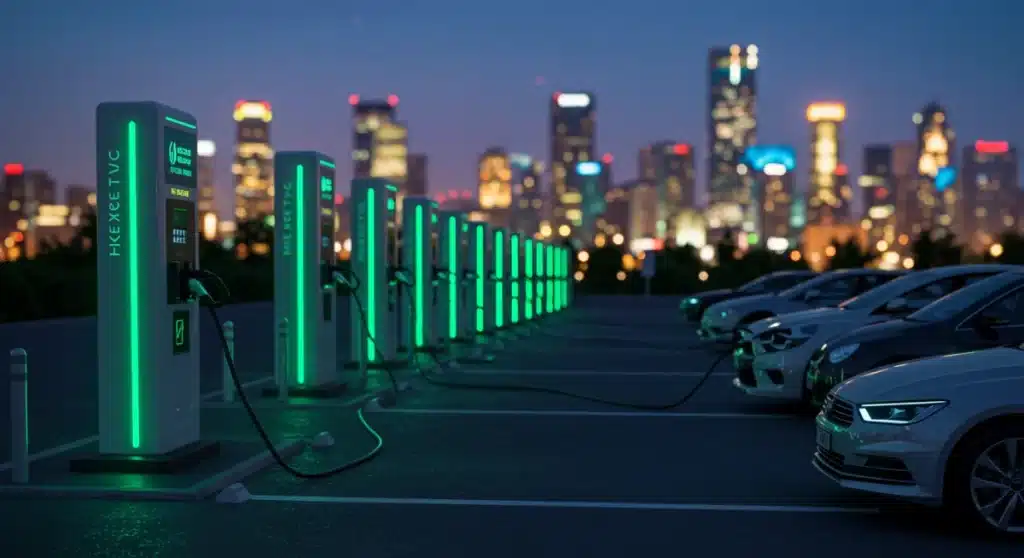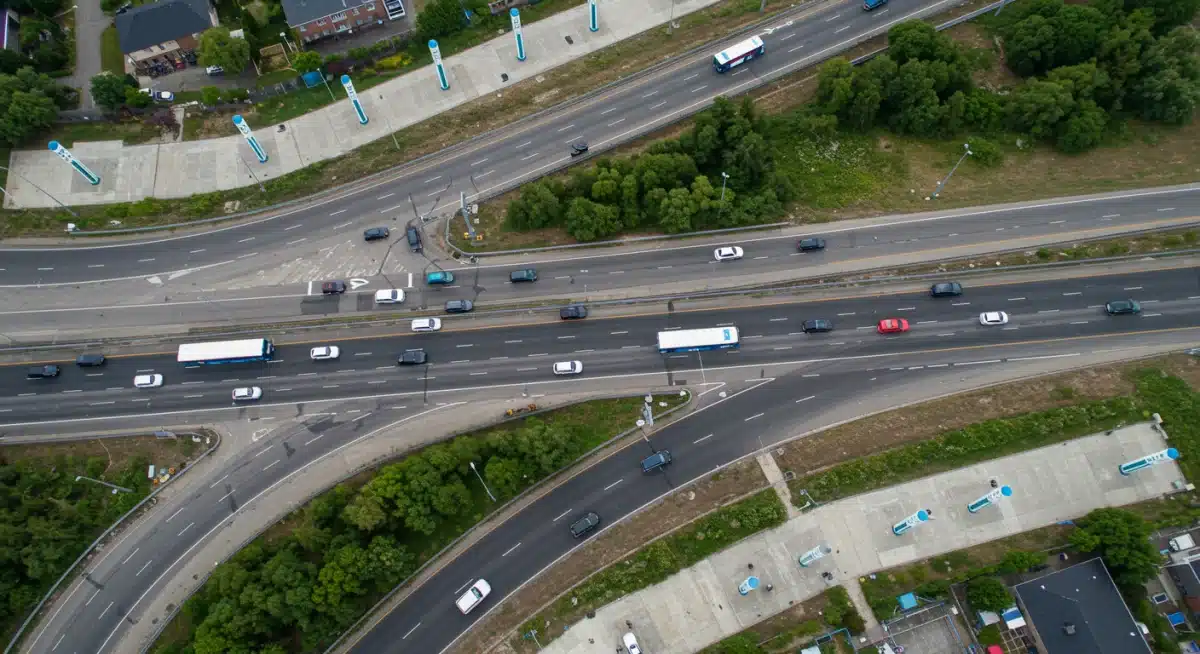EV Charging Infrastructure: US 2025 Roadmap to 30% Boost

The United States government has unveiled an ambitious 2025 roadmap targeting a 30% increase in public electric vehicle charging infrastructure, signaling a significant push to accelerate EV adoption and meet growing demand.
The United States is currently navigating a pivotal moment in its transition to sustainable transportation. A new roadmap aims to significantly expand the nation’s EV Charging Infrastructure U.S., with a bold target of increasing public charge points by 30% by 2025. This initiative is critical for supporting the rapidly growing electric vehicle market and addressing range anxiety among consumers.
The 2025 Roadmap: A Strategic Overview
The recently announced 2025 roadmap outlines a comprehensive strategy to bolster the nation’s electric vehicle charging capabilities. This plan is not merely about increasing the number of chargers; it emphasizes strategic placement, reliability, and accessibility to ensure a seamless charging experience for all EV owners.
Central to this roadmap is a multi-agency collaboration, combining federal funding with private sector innovation. The goal is to create a robust and resilient charging network that can support millions of electric vehicles on American roads, reducing carbon emissions and fostering energy independence.
Key Pillars of Expansion
The expansion strategy rests on several foundational pillars, each designed to address specific challenges in the current charging landscape.
- Funding Allocation: Substantial federal investments are being channeled through programs like the National Electric Vehicle Infrastructure (NEVI) Formula Program, aiming to unlock billions in private capital.
- Standardization and Interoperability: Efforts are underway to ensure charging stations are universally compatible, reducing confusion for consumers and streamlining the charging process.
- Rural and Underserved Communities: A significant focus is placed on deploying chargers in areas historically overlooked, ensuring equitable access to EV infrastructure across the country.
Federal Funding and Incentives Driving Growth
Federal funding plays a crucial role in accelerating the deployment of EV Charging Infrastructure U.S. The Biden-Harris administration has committed substantial resources, recognizing that a robust charging network is fundamental to the nation’s clean energy goals. These investments are designed to stimulate both supply and demand within the EV ecosystem.
Incentives extend beyond direct funding for infrastructure projects. Tax credits for individuals purchasing EVs and for businesses installing charging stations are also part of the broader strategy. These financial encouragements aim to make EV ownership more attractive and charging solutions more widespread.
The NEVI Program’s Impact
The National Electric Vehicle Infrastructure (NEVI) Formula Program, established under the Bipartisan Infrastructure Law, is a cornerstone of this effort. It allocates billions to states to build out a national EV charging network, particularly along designated alternative fuel corridors.
As of late 2023, every state has approved its NEVI plan, with initial funding already being deployed. This program mandates specific reliability and interoperability standards, ensuring that the new charging stations are not only numerous but also high-quality and user-friendly. This coordinated approach is critical for achieving the 30% increase target by 2025.
Technological Advancements in Charging Solutions
Innovation in charging technology is advancing rapidly, offering faster, more efficient, and more convenient solutions for EV owners. These advancements are integral to the 2025 roadmap, as they enhance the user experience and make EVs a more viable option for daily commuting and long-distance travel.
The focus is on developing and deploying next-generation chargers that can significantly reduce charging times. This includes ultra-fast DC chargers, smart charging systems, and even wireless charging technologies that are beginning to emerge from research and development into pilot programs.

Smart Charging and Grid Integration
Smart charging technologies are becoming increasingly important for managing the load on the electrical grid. These systems can optimize charging times, often charging vehicles during off-peak hours when electricity is cheaper and demand is lower. This not only benefits consumers but also helps stabilize the grid.
- Load Balancing: Smart chargers can distribute power efficiently across multiple vehicles, preventing overloads and ensuring consistent service.
- Vehicle-to-Grid (V2G) Technology: Emerging V2G systems allow EVs to feed power back into the grid during peak demand, turning electric vehicles into mobile energy storage units.
- Dynamic Pricing: Integration with utility pricing models encourages charging when renewable energy sources are abundant, promoting greener energy consumption.
Addressing Challenges in Deployment and Adoption
Despite significant progress, the deployment of EV Charging Infrastructure U.S. faces several challenges. These include grid capacity limitations, permitting complexities, and ensuring equitable access across diverse communities. Overcoming these hurdles is essential for the successful implementation of the 2025 roadmap.
Local permitting processes can often be slow and inconsistent, delaying the installation of new charging stations. Efforts are being made to streamline these procedures and provide clearer guidelines for developers and municipalities. Additionally, ensuring the grid can handle the increased electrical load from widespread EV charging requires substantial upgrades and modernization.
Overcoming Grid Constraints and Permitting Hurdles
Utilities are actively investing in grid upgrades and smart grid solutions to accommodate the growing demand from EVs. This involves enhancing transmission and distribution infrastructure, as well as integrating more renewable energy sources to power the charging network sustainably.
Policy initiatives are also targeting permitting processes, with federal and state governments working to standardize requirements and accelerate approvals for charging station installations. This collaborative effort among government agencies, utilities, and private developers is critical for maintaining momentum towards the 2025 target.
The Role of Private Sector Innovation and Partnerships
The private sector is a vital partner in expanding EV Charging Infrastructure U.S., bringing innovation, capital, and operational expertise to the table. Companies are investing heavily in developing new charging technologies, building out networks, and offering various services to EV drivers.
Partnerships between car manufacturers, charging network operators, and energy companies are accelerating deployment and improving the user experience. These collaborations often lead to integrated solutions, such as in-car navigation that directs drivers to available chargers and seamless payment systems.
Innovative Business Models
Innovative business models are emerging to make charging more accessible and affordable. This includes subscription services, loyalty programs, and partnerships with retail establishments and workplaces to host charging stations. These models aim to integrate charging into daily routines, making it as convenient as refueling a gasoline car.
- Charging-as-a-Service (CaaS): Companies offer comprehensive charging solutions for businesses and residential complexes, managing installation, maintenance, and operation.
- Retail Integration: Shopping centers, restaurants, and hotels are increasingly installing chargers to attract EV drivers, creating a win-win situation for businesses and consumers.
- Workplace Charging: Employers are providing charging options for their employees, supporting sustainable commuting and boosting employee satisfaction.
Community Engagement and Public Awareness Campaigns
Successful expansion of EV Charging Infrastructure U.S. also relies heavily on community engagement and public awareness. Educating consumers about the benefits of EVs and the availability of charging options is crucial for increasing adoption rates and ensuring the new infrastructure is utilized effectively.
Public awareness campaigns are being rolled out at both national and local levels, highlighting the environmental and economic advantages of electric vehicles. These campaigns often address common misconceptions about EVs, such as range anxiety and charging availability.
Educational Initiatives and Local Outreach
Local governments and community organizations are playing a key role in these efforts. Workshops, test drive events, and informational sessions are being organized to provide hands-on experience and answer questions from potential EV owners.
These initiatives help build confidence in EV technology and the charging infrastructure, fostering a supportive environment for electric vehicle adoption. The goal is to ensure that as charging points increase, so too does the public’s understanding and acceptance of electric mobility.
Projected Impact and Future Outlook
Achieving a 30% increase in public EV Charging Infrastructure U.S. by 2025 will have a transformative impact on the nation’s transportation landscape. This expansion is expected to significantly reduce range anxiety, making electric vehicles a more viable and attractive option for a broader segment of the population.
The enhanced infrastructure will also support the growing number of EV models entering the market, from compact cars to electric trucks and buses. This comprehensive approach is not just about meeting a numerical target; it’s about laying the groundwork for a sustainable, electrified future.
Long-Term Vision for EV Infrastructure
Beyond 2025, the roadmap sets the stage for continuous growth and innovation. The long-term vision includes a fully integrated, smart charging network capable of supporting a predominantly electric vehicle fleet. This involves ongoing research into advanced battery technologies, faster charging methods, and even more efficient energy management systems.
The ultimate goal is to create an EV ecosystem where charging is as ubiquitous and convenient as gasoline stations are today, paving the way for a cleaner, healthier, and more energy-independent nation.
| Key Point | Brief Description |
|---|---|
| 2025 Target | Aim for a 30% increase in U.S. public EV charging points by 2025. |
| Federal Funding | Significant investment via NEVI program and other incentives to expand infrastructure. |
| Technological Focus | Advancing ultra-fast DC charging, smart grid integration, and V2G technologies. |
| Challenges Addressed | Streamlining permitting, grid upgrades, and ensuring equitable access. |
Frequently Asked Questions About EV Charging Infrastructure U.S.
The primary goal is to achieve a 30% increase in public electric vehicle charging points across the U.S. by 2025. This expansion aims to support the growing number of EVs and alleviate range anxiety, making electric transportation more accessible and convenient nationwide.
The expansion is primarily funded through programs like the National Electric Vehicle Infrastructure (NEVI) Formula Program, established under the Bipartisan Infrastructure Law. This federal funding is supplemented by various tax credits and incentives for both consumers and businesses, encouraging private sector investment.
Key technological advancements include the deployment of ultra-fast DC chargers, smart charging systems for optimized grid management, and emerging Vehicle-to-Grid (V2G) capabilities. These innovations enhance charging speed, efficiency, and integration with the broader energy grid.
Challenges include grid capacity limitations, which require substantial upgrades, and complex local permitting processes that can delay installations. Efforts are underway to streamline these procedures and modernize the grid to support the increased electrical demand from EVs.
The private sector contributes through significant investments in new charging technologies, development of charging networks, and offering innovative services like Charging-as-a-Service. Partnerships with car manufacturers and energy companies are crucial for creating integrated and user-friendly charging solutions.
What Happens Next
The momentum behind the 2025 roadmap for EV Charging Infrastructure U.S. continues to build. As federal funds are dispersed and state-level plans mature, expect a visible acceleration in charger installations across the nation. Stakeholders will be closely monitoring the effectiveness of new technologies and the streamlining of permitting processes. The coming months will reveal critical insights into how quickly grid upgrades can keep pace with demand, and how effectively rural and underserved communities are integrated into the expanded network. This ongoing development is pivotal for America’s clean energy future.





